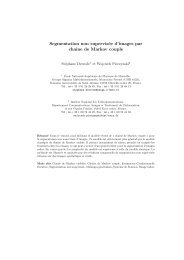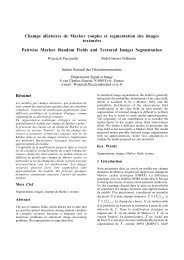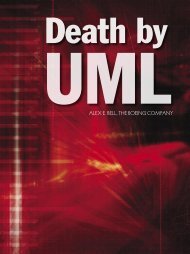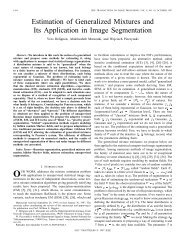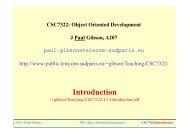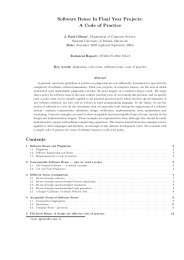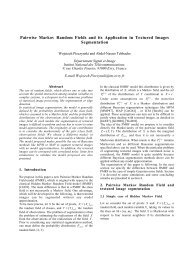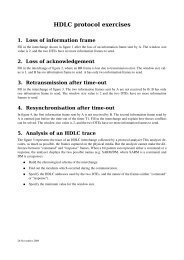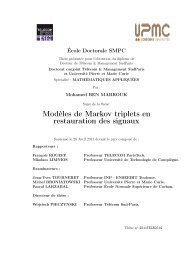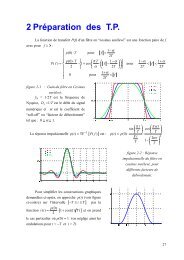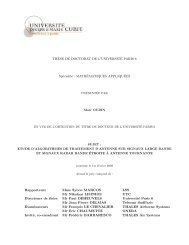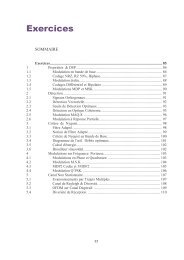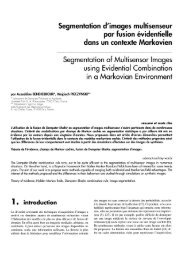Multisensor triplet Markov fields and theory of evidence
Multisensor triplet Markov fields and theory of evidence
Multisensor triplet Markov fields and theory of evidence
You also want an ePaper? Increase the reach of your titles
YUMPU automatically turns print PDFs into web optimized ePapers that Google loves.
W. Pieczynski, D. Benboudjema / Image <strong>and</strong> Vision Computing 24 (2006) 61–69 63<br />
distribution <strong>of</strong> X: if we replace either M 0 or M 1 by a bba which is<br />
not null outside singletons, then the fusion M 0 <strong>and</strong> M 1 gives a<br />
probability which is an extension <strong>of</strong> the posterior distribution <strong>of</strong><br />
X. Such a fusion result can then be used, in a strictly same<br />
manner as the classical one, in different Bayesian techniques for<br />
estimating X from YZy. Studying these different extensions in<br />
the <strong>Markov</strong> <strong>fields</strong> context is the very aim <strong>of</strong> the paper.<br />
Let us consider the following two examples, which briefly<br />
describe how the DS fusion can be used in the image analysis<br />
context.<br />
Example 2.1. Let us consider the problem <strong>of</strong> satellite or<br />
airborne optical image segmentation into two classes UZ{u 1 ,<br />
u 2 } ‘forest’ <strong>and</strong> ‘water’. Thus we have two r<strong>and</strong>om <strong>fields</strong> XZ<br />
(X s ) s2S <strong>and</strong> YZ(Y s ) s2S , each X s taking its values in UZ{u 1 ,<br />
u 2 } <strong>and</strong> each Y s taking its values in R. Let us assume that there<br />
are clouds <strong>and</strong> let us denote by u c the ‘clouds’ class. Thus, in<br />
the classical probabilistic context, there are three conditional<br />
distributions on R:p(y s jx s Zu 1 ), p(y s jx s Zu 2 ) <strong>and</strong> p(y s jx s Zu c ).<br />
This classical model admits the following ‘evidential’<br />
interpretation. If we are only interested on the classes<br />
UZ{u 1 ,u 2 }, the class u c brings no information about them,<br />
<strong>and</strong> thus u c models the ignorance <strong>and</strong> is assimilated to U.<br />
Finally, the classical probability q y s<br />
defined on {u 1 ,u 2 ,u c }by<br />
q y s<br />
ðu 1 Þfpðy s jx s Zu 1 Þ, q y s<br />
ðu 1 Þfpðy s jx s Zu 2 Þ, <strong>and</strong> q y s<br />
ðu 1 Þf<br />
pðy s jx s Zu c Þ is interpreted as a bba M 2 defined on P(U)Z{u 1 ,<br />
u 2 ,U} byM 2 ({u 1 })fp(y s jx s Zu 1 ), M 2 ({u 2 })fp(y s jx s Zu 2 ),<br />
<strong>and</strong> M 2 (U)fp(y s jx s ZU). In other words, M 2 (U) models the<br />
ignorance attached with the fact that one cannot see through<br />
clouds. An interesting result states that when M 1 is a <strong>Markov</strong><br />
probabilistic field distribution, its DS fusion with M 2 remains a<br />
<strong>Markov</strong> distribution, which generalizes the classical calculus<br />
<strong>of</strong> <strong>Markov</strong> posterior distribution [3]. Furthermore, when clouds<br />
disappear, M(U) becomes null, <strong>and</strong> such a ‘generalized’<br />
<strong>Markov</strong> model becomes a classical HMF. So, the generalization<br />
we obtain embeds HMF particular case. Different<br />
Bayesian processing methods can then be based on the fused<br />
<strong>Markov</strong> distribution obtained this way. Roughly speaking,<br />
when the prior distribution is a <strong>Markov</strong> probabilistic bba, its<br />
fusion with a more general evidential bba does not pose<br />
problem <strong>and</strong> Bayesian processing remains workable in this<br />
more general context.<br />
Example 2.2. Let us consider the problem <strong>of</strong> segmentation <strong>of</strong><br />
an observed bi-sensor image YZ(Y 1 ,Y 2 )Z(y 1 ,y 2 ) into three<br />
classes. So, we have UZ{u 1 ,u 2 ,u 3 }. Imagine that the first<br />
sensor Y 1 is sensitive to u 1 ,u 2 ,u 3 <strong>and</strong> {u 1 ,u 2 ,u 3 } (to fix ideas,<br />
it is an optical satellite sensor <strong>and</strong> there are clouds, modeled as<br />
in Example 2.1). Imagine that the second sensor Y 2 is sensitive<br />
to {u 1 ,u 2 } <strong>and</strong> u 3 (to fix ideas, it is an infrared satellite sensor<br />
<strong>and</strong> u 1 , u 2 are ‘hot’, while u 3 is ‘cold’). Let L 1 Z<br />
{{u 1 },{u 2 },{u 3 },{u 1 ,u 2 ,u 3 }}, L 2 Z{{u 1 ,u 2 },{u 3 }}, <strong>and</strong><br />
L 1,2 Z{{u 1 },{u 2 },{u 3 },{u 1 ,u 2 }}. As above, y 1 defines a<br />
probability M 1 on L 1 <strong>and</strong>, in a similar way, y 2 defines a<br />
probability M 2 on L 2 .AsM 1 <strong>and</strong> M 2 are also bbas on P(U), we<br />
can fuse them, <strong>and</strong> the result M 3 ZM 1 4M 2 is a probability on<br />
L 1,2 . Finally, M 3 can be fused with a probabilistic <strong>Markov</strong><br />
field, resulting in a <strong>Markov</strong> distribution which extends the<br />
classical posterior distribution.<br />
3. Triplet <strong>Markov</strong> <strong>fields</strong> with evidential priors<br />
Let S be the set <strong>of</strong> pixels, <strong>and</strong> X,Y two r<strong>and</strong>om <strong>fields</strong> defined<br />
on S as specified in Section 1. Thus for each s2S, the variables<br />
X s <strong>and</strong> Y s take their values in UZ{u 1 ,.,u k } <strong>and</strong> R,<br />
respectively. The problem is to estimate X from Y, with<br />
immediate application to image segmentation. Considering a<br />
<strong>triplet</strong> <strong>Markov</strong> field (TMF), consists in introducing a third<br />
r<strong>and</strong>om field UZ(U s ) s2S , where each U s takes its values in<br />
LZ{l 1 ,.,l m }, <strong>and</strong> in assuming that TZ(X,U,Y) is a <strong>Markov</strong><br />
field. The distribution <strong>of</strong> TZ(X,U,Y) is then a classical Gibbs<br />
one:<br />
"<br />
pðtÞ Z g exp K X #<br />
4 c ðt c Þ<br />
(3.1)<br />
c2C<br />
Classically, (3.1) means that the distribution <strong>of</strong> T verifies<br />
p(t s jt r ,rss)Zp(t s jt r ,r2W s ), where (W s ) s2S is some neighborhood<br />
system (W s is the set <strong>of</strong> neighbors <strong>of</strong> s). C is the set <strong>of</strong><br />
cliques associated with (W s ) s2S (a clique is either a singleton,<br />
or a set <strong>of</strong> mutually neighbors pixels).<br />
In this model, X <strong>and</strong> Y are interpreted as usual, as for U, it<br />
can have physical meaning or not. More precisely, there are at<br />
least three situations in which U models some reality: (i) the<br />
noise densities are unknown, <strong>and</strong> are approximated by<br />
Gaussian mixtures; (ii) there are subclasses in at least one<br />
class among u 1 ,.,u k ; <strong>and</strong> (iii) U models different stationarities<br />
<strong>of</strong> the field X (see [1] for (i) <strong>and</strong> (ii), <strong>and</strong> [2] for (iii)).<br />
Important is that (X,U) can be classically simulated<br />
according to the <strong>Markov</strong> distribution p(x,ujy), which enables<br />
to implement their different Bayesian estimations methods. For<br />
example, the classical Maximum Posterior Mode (MPM)<br />
method gives ^xZð^x s Þ s2S such that for each s2S<br />
pð^x s jyÞZmax xs 2U pðx s jyÞ. This estimate can be computed<br />
once the posterior marginal distributions p(x s jy) are known:<br />
as p(x s ,u s jy) can be classically estimated from a simulated<br />
sample, p(x s jy) is given by pðx s jyÞZ P u s 2L pðx s ; u s jyÞ. Of<br />
course, U can be estimated similarly if it is <strong>of</strong> interest [2].<br />
We now deal with the main point <strong>of</strong> this paper, i.e. we want<br />
to explain how the classical computing <strong>of</strong> the posterior<br />
distribution in hidden <strong>Markov</strong> <strong>fields</strong> can be extended to DS<br />
fusion when the hidden data become ‘evidential’. Let us<br />
consider the classical hidden <strong>Markov</strong> field, with pðxÞZ<br />
g exp K P Q<br />
c2C 4 c ðx c Þ <strong>and</strong> pðyjxÞZ s2S pðy s jx s Þ. Then the<br />
distribution <strong>of</strong> (X,Y) is defined by<br />
"<br />
pðx; yÞ Z g exp K X 4 c ðx c Þ C X #<br />
Log½pðy s jx s ÞŠ (3.2)<br />
c2C<br />
s2S<br />
The key point is to use the observation that p(xjy) given by<br />
(3.2) can be seen as the result <strong>of</strong> the DS fusion <strong>of</strong> pðxÞZ<br />
g exp K P <br />
c2C 4 c ðx c Þ with the probability distribution q y (x)<br />
(y is fixed) obtained by normalizing p(yjx). More precisely,<br />
putting



